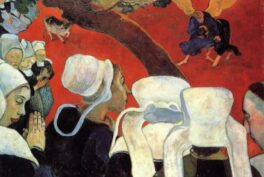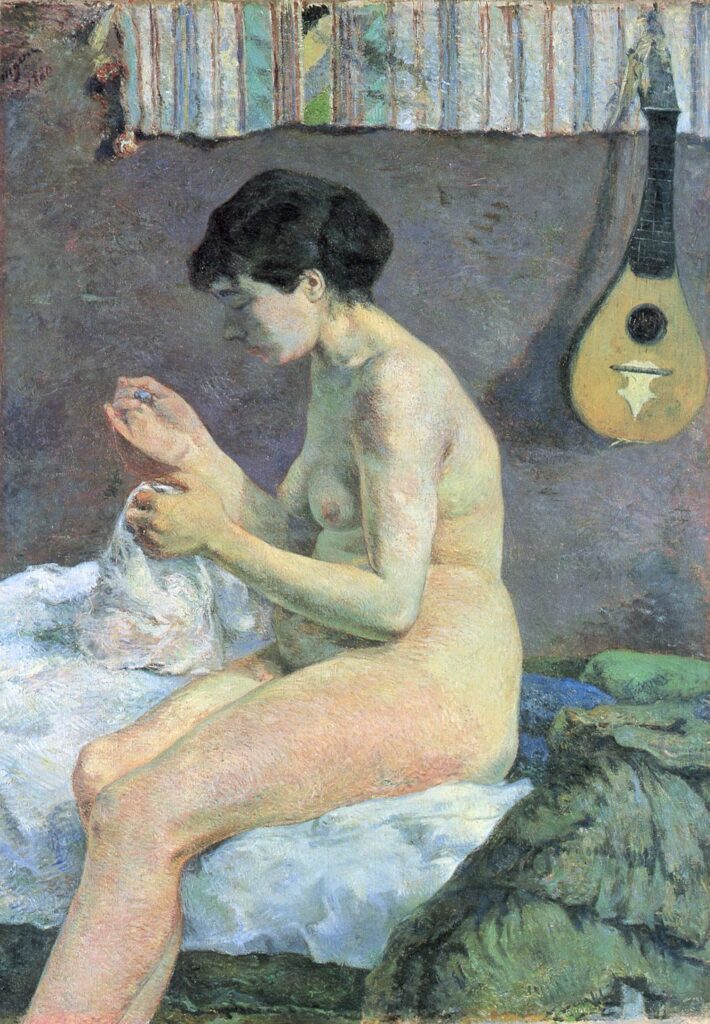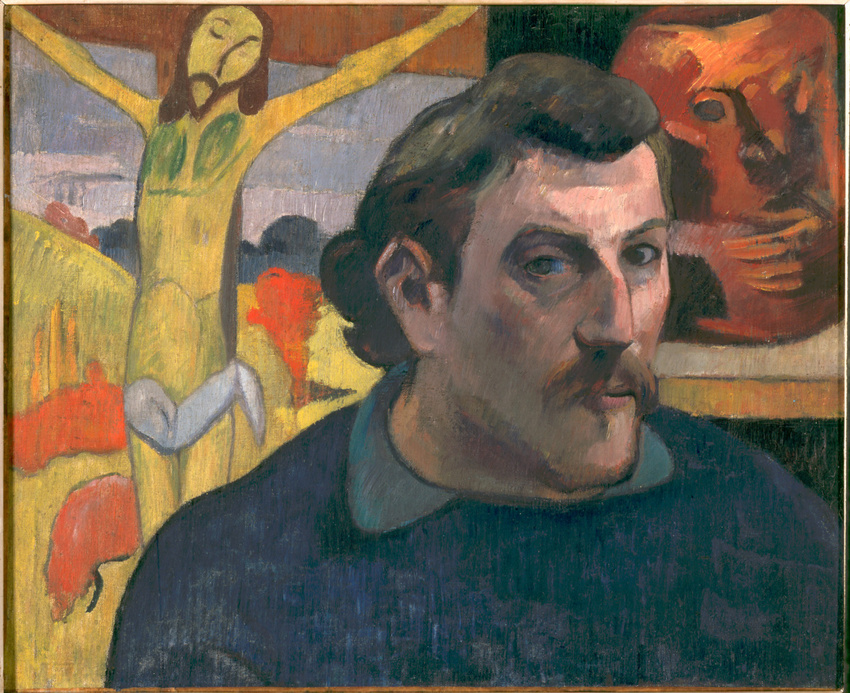In his paintings, Gauguin combined Christian themes with Pagan rituals and filled his art with deep meaning. You will learn about his creative path in 10 significant paintings by the artist.
1. Study of a Nude, or Suzanne Sewing
Paul Gauguin was born into the family of a political journalist and a feminist. He spent his childhood in Peru and his youth on a ship in navigation. That background would leave an imprint on the formation of the artist’s interests. Gauguin started his art career late by those standards at the age of 35. Being a father, a stockbroker, and a collector of paintings, Paul Gauguin decided to devote his life to art after the collapse of the stock exchange. He was friends with Camille Pissarro and Edgar Degas, and at the beginning of his career, you can see that his paintings were influenced by masters of Impressionism.
2. Nature Morte à la Mandoline
However, Gauguin soon abandoned the impressionistic technique. According to Gauguin, Impressionists were occupied only with the external and did not pay due attention to the deep meanings and secrets of life. Gradually, he moved away from the separate brushstroke and moved towards the planes of color. So, his paintings became more two-dimensional, and he used line and color as complementary possibilities of expression.
3. The Vision after the Sermon
At the same time, Gauguin sought to create his own way of painting and dreamed of finding primevalness and went to Brittany for it. At the end of the 19th century, this region of France was perceived by the inhabitants of the capital as a deep village. There people wore traditional clothes and adhered to the old rituals.
In the city of Pont-Aven, Gauguin joined the artists of the Pont-Aven school, developing ideas for a new simplified and expressive direction in painting – Synthetism. Gauguin painted Vision after Sermon, in which he revealed to the audience the vision presented to the Breton peasant women at the moment of prayer. As you can see, Gauguin used bright color planes; the colors did not mix with each other. This technique is associated with Cloisonnism.
4. The Painter of Sunflowers
Gauguin was a friend of the Dutch painter Vincent van Gogh. Van Gogh invited Gauguin to Arles, where he dreamed of creating a colony of free artists, but the idea was utopian. Gauguin and Van Gogh lived and worked together, but the difference in characters made itself felt. So, after a nervous breakdown of the sensitive Van Gogh, Paul Gauguin left Arles. Van Gogh created Paul Gauguin’s Chair, sublimating his loneliness and the loss of a friend.
5. Self-Portrait with the Yellow Christ
During his life, Paul Gauguin painted several vivid self-portraits. However, this picture is special. It combines three self-portraits and a quotation of himself. The yellow Christ echoes Gauguin’s painting of the same name and has the features of the artist himself. It is believed that the inspiration for him was the Breton crucifixion. On the right, the painting depicts a vessel, “the head of a wild Gauguin.” Thus, the artist combined in this picture his own wildness, primeval spirit, and the fate of a martyr.
After the dramatic episode with Van Gogh, Paul Gauguin went to Tahiti, where he hoped to meet with primitiveness. However, the islands had already been invaded by missionaries. Women wore closed dresses, and savagery was a thing of the past. Despite this, Gauguin created a Tahitian series and continued to develop his myth of a beautiful paradise island. In the painting Ia Orana Maria, Gauguin combined a Christian plot and depicted the Virgin Mary and the Child in bright Tahitian clothes.
This is what the halos above their heads tell us. Worshipping people are visible behind. It is noteworthy that Gauguin probably focused on the stone reliefs in the Borobudur temple on the island of Java for their image. Thus, the picture represents a synthesis of cultures. Moreover, Gauguin challenged European culture by creating his own image of Madonna and Child.
7. Spirit of the Dead Watching (Manao tupapau)
In the tropics, Gauguin developed his original style, which set him apart from the European painters. The artist violated the laws of anatomy and perspective in the name of the expressiveness of figures; he destroyed the verisimilitude of color in painting. The painting Spirit of the Dead Watching (Manao tupapau) was inspired by the local myths of the inhabitants of Tahiti. Lying on the bed, Tehura (Gauguin’s 13-year-old wife) was frightened by the death demon Tupapau, appearing in the dark. Gauguin mixed the otherworldly with reality. There are no bright colors like in the painting Ia Orana Maria, so purple and blue create a mystical atmosphere.
8. The Queen or The King’s Wife
Gauguin continued conducting a dialogue with European art. In the painting The King’s Wife, the woman resembled Edouard Manet’s Olympia. After all, such iconography is very recognizable. However, art historians developed several theories according to the object of inspiration for Gauguin’s painting. For example, R. Brettell voiced the hypothesis that Gauguin used the figure of a reclining monk from one of the reliefs of the Borobudur temple in Java as a prototype.
9. Where Do We Come From? What Are We? Where Are We Going?
This masterpiece by Paul Gauguin was painted in Tahiti, after which the artist was going to commit suicide by poisoning himself in the mountains with arsenic. However, the attempt was unsuccessful. The painting is an attempt to comprehend philosophical questions: who we are, where we’re going, where we came from. The picture should be read from right to left. A baby is a human soul and the beginning of life. Three women sitting next to each other resemble Greek Moiras that decide a person’s fate.
The central part of the canvas represents the period of human maturity. The figure reaching for the fruit clearly refers to the biblical episode with the forbidden fruit from the Tree of Knowledge. The left part ends with an old woman and death. In all this earthly world, a figure with a blue glow stands out especially. It is from the Beyond. Gauguin was convinced that this canvas surpassed all his previous paintings.
10. Still Life with Parrots
At the end of his life, Gauguin suffered from diseases on exotic islands, attempted suicide, and possibly had a premonition of his death. In the picture, we see a still life, executed in bright colors, pleasing to the eye. However, not everything is so joyful and full of life. On the table are dead parrots, a cut flower, a water vessel, and an idol behind.
The birds are already dead. The flower will wither quickly without water. The idol can be interpreted as the goddess of the Moon Hina. A vessel for water asks a question about which way the traveler is going. Thus, despite the bright colors, the painting tells us a gloomy story.
Paul Gauguin was a self-taught painter. He created a world of his own thoughts and fantasies, created his own mythology. Having mastered the technical skills of Impressionists, he felt an irresistible need to find his own way in art, which would allow him to express his thoughts and ideas. A distinctive feature of Gauguin’s work is his desire to go beyond the worldview on the basis of which European art has developed. Hence his rejection of the Greek art of the classical era with his desire for ideal proportions and the artist’s appeal to the Greek archaic, which had many points of contact with the culture of the East.
Nowadays, Gauguin’s journey and time spent in Tahiti is considered a troubling legacy. His Polynesian paintings are one of his finest works. But after that gasp of sensual delight upon seeing the work, we must remember that these brown-skinned nudes were more than just Paul Gauguin’s models – they were native women of whom he took advantage. After leaving his wife and children in Paris, Gauguin “married” local underaged girls, infecting them with syphilis, and slept with countless others. Modern public sensitivity to issues of race, colonialism, and gender means we need to reassess his paintings in a new light.

















